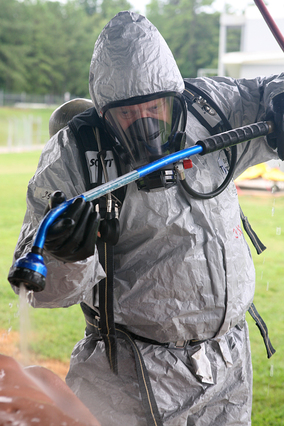
Anniston, AL, August 4, 2011 -- Todd Jones, superintendent of the Center for Domestic Preparedness (CDP), simulates decontamination of a survivor during an exercise at the center. The CDP, in Anniston, Ala. instructs responders to determine their response tactics, select required equipment, personal protective levels, and decontamination procedures. The CDP specializes in providing advanced, hands-on, all-hazards training for state, local, and tribal emergency responders.
As the superintendent of the Center for Domestic Preparedness, when I have the opportunity, I believe it is important to participate in our courses to see first-hand how well our training meets the needs of the responder community and what we can do to improve our courses in order to better support their training needs.
I’ve blogged about the payoff of emergency preparedness training, but last week I saw the hands-on training offered at FEMA’s Center for Domestic Preparedness at a whole new level. I had the privilege of training alongside responders from across the nation in the Technical Emergency Response Training course or TERT as it’s called. The TERT course provides the fundamental skills responders need to answer the call to a chemical, biological, radiological, nuclear, or explosive incident.
I was struck by both the complexity and the unique challenges responders face with these hazards. Having gone through TERT, it’s obvious to me that the hands-on training we received, combined with the opportunity to practice these skills in a live toxic agent environment, are critically important in preparing our firefighters, police officers, emergency medical professionals, and other response providers to safely and effectively save lives in a potentially deadly incident.
Anniston , AL, August 4, 2011 -- Center for Domestic Preparedness (CDP) Superintendent Todd Jones (pictured front-left), along with other members of his team, carry a simulated victim through the decontamination process during an exercise at the CDP. The CDP, in Anniston, Ala. instructs responders to determine their response tactics, select required equipment, personal protective levels, and decontamination procedures. Responding to All-Hazards, Mass-casualty events is a highlight and core principle behind CDP training.
Anniston, AL, August 4, 2011 -- (Left to Right) New York Fire Fighters Donald Cosman and William Farrell stand with Todd Jones, superintendent of the Center for Domestic Preparedness (CDP), following a training exercise at the Chemical, Ordnance, Biological, and Radiological (COBRA) Training Facility. COBRA courses prepare responders for a CBRNE incident by providing them the opportunity to practice their knowledge and skills in the nation’s only toxic chemical training facility for civilian emergency responders.
The threat awareness portion of this course reaffirmed to me that these hazards still exist today and having a trained cadre of responders to handle such events is a key factor in our overall preparedness as a nation. At CDP, it’s our mission to provide meaningful, interactive and hands-on training for emergency responders to build our capacity to prevent and respond to emergencies in their communities – I encourage you to learn more about what we can offer to emergency responders across all levels.
My Story of First Responder Training
For more information about CDP’s TERT course from the students’ perspective, check out this video:
Last Updated:
06/19/2012 - 11:52

Comments
My experiences at the Center for Domestic Prepared...
Add new comment